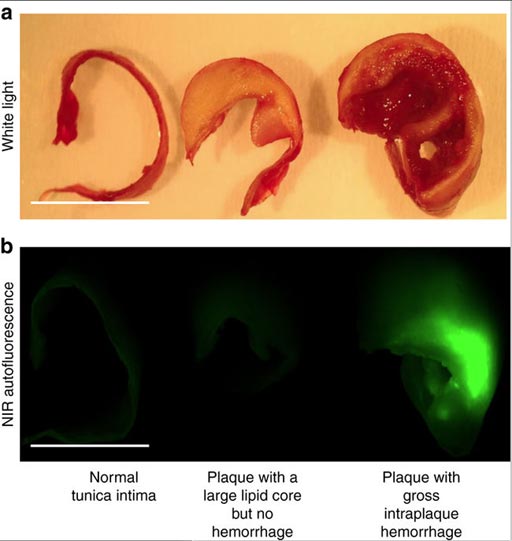NIR Laser Helps Identify Heart Attack and Stroke Risk
By MedImaging International staff writers
Posted on 29 Aug 2017
A new study suggests that near-infrared (NIR) autofluorescence imaging could aid early detection of high-risk atherosclerotic plaques and intra-plaque hemorrhage.Posted on 29 Aug 2017
In a study at Monash University (Melbourne, Australia), the University of Warwick (Coventry, United Kingdom), and other institutions, researchers found that heme degradation products--particularly bilirubin--can be detected by increasing the wavelength of infrared (IR) illumination--currently used to detect fatty deposit build-up in arteries--to NIR wavelengths. In a mouse model, fluorescence emission computed tomography (CT) detected the NIR autofluorescence of heme products and intra-plaque bleeding via Raman spectroscopy.

Image: An NIR autofluorescence of heme products can detect bleeding plaques (Photo courtesy of Karlheinz Peter).
Heme by-products, especially bilirubin, were only observed in unstable plaques with internal bleeding, and were not observed in the more stable fatty deposits. Similar results were seen when the researchers examined human carotid endarterectomy (CEA) specimens collected from patients who presented to the Alfred Hospital (Melbourne, Australia). According to the researchers, the improved selectivity for high-risk atherosclerotic deposits could help doctors to identify the most at-risk patients. The study was published on July 13, 2017, in Nature Communications.
“We realized when we shine a light in the near-infrared wavelength range, that this light is reflected at a certain wavelength. So in a way we can use laser light to shine up the plaques that are unstable, and it's very characteristic,” said senior author Karlheinz Peter, MD, of Monash University. “After further investigation with clinical trials, this method of imaging technique could be used to assess unstable fatty arterial plaques, and could be used to monitor the effectiveness of the drugs used to prevent heart attacks or strokes.”
Bilirubin is the yellow pigmented breakdown product of normal heme catabolism, caused by the body's clearance of aged red blood cells (RBCs), which contain hemoglobin. It is excreted in bile and urine, and elevated levels may indicate certain diseases. Bilirubin is responsible for the yellow color of bruises and the yellow discoloration in jaundice. It is also responsible for the brown color of feces, via its conversion to stercobilin, and the background straw-yellow color of urine via its breakdown product, urobilin.
Related Links:
Monash University
University of Warwick




 Guided Devices.jpg)









